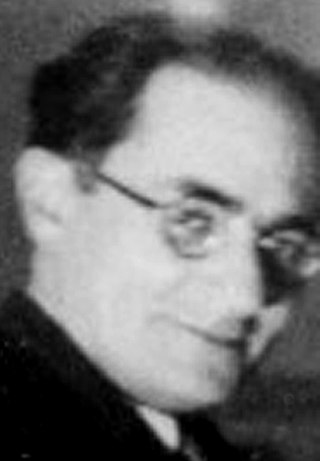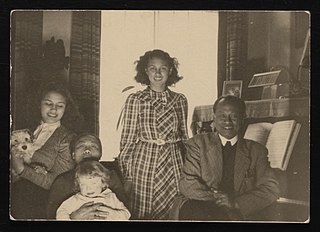
Chaim Mordechaj Rumkowski was the head of the Jewish Council of Elders in the Łódź Ghetto appointed by Nazi Germany during the German occupation of Poland.

Hans Biebow was the chief of German Nazi administration of the Łódź Ghetto in occupied Poland.

The Łódź Ghetto or Litzmannstadt Ghetto was a Nazi ghetto established by the German authorities for Polish Jews and Roma following the Invasion of Poland. It was the second-largest ghetto in all of German-occupied Europe after the Warsaw Ghetto. Situated in the city of Łódź, and originally intended as a preliminary step upon a more extensive plan of creating the Judenfrei province of Warthegau, the ghetto was transformed into a major industrial centre, manufacturing war supplies for Nazi Germany and especially for the Wehrmacht. The number of people incarcerated in it was increased further by the Jews deported from Nazi-controlled territories.

Edith Frank was the mother of Holocaust diarist Anne Frank, and her older sister Margot. After the family were discovered in hiding in Amsterdam during the Nazi occupation, she was transported to Auschwitz-Birkenau concentration camp.

Jane Mathison Haining was a Scottish missionary for the Church of Scotland in Budapest, Hungary, who was recognized in 1997 by Yad Vashem in Israel as Righteous Among the Nations for having risked her life to help Jews during the Holocaust.

Stella Ingrid Goldschlag, also known as Stella Kübler-Isaacksohn and Stella Kübler was a German Jewish woman who collaborated with the Gestapo during World War II, operating around Berlin exposing and denouncing Berlin's underground Jews.

Anita Lasker-Wallfisch is a German-British cellist, and a surviving member of the Women's Orchestra of Auschwitz.

Lucille Eichengreen was a survivor of the Łódź (Litzmannstadt) Ghetto and the Nazi German concentration camps of Auschwitz, Neuengamme and Bergen-Belsen. She moved to the United States in 1946, married, had two sons and worked as an insurance agent. In 1994, she published From Ashes to Life: My Memories of the Holocaust. She frequently lectured on the Holocaust at libraries, schools and universities in the U.S. and Germany. She took part in a documentary from the University of Giessen on life in the Ghetto, for which she was awarded an honorary doctorate.

Abraham Gancwajch (1902–1943) was a prominent Nazi collaborator in the Warsaw Ghetto during the World War II occupation of Poland, and a Jewish kingpin of the ghetto underworld. Opinions about his ghetto activities are controversial, though modern research concludes unanimously that he was an informer and collaborator motivated chiefly by personal interest.

Gerhard "Gad" Beck was an Israeli-German educator, author, activist, resistance member, and survivor of the Holocaust.

Marianne Cohn, was a German-born French Resistance fighter.
The Bund: Gemeinschaft für ein sozialistisches Leben was a German Socialist organization founded in 1924 by Artur Jacobs. Dore Jacobs, created within this "Bund" a method of physical education which became a mode of resistance under Nazism and is still taught in Germany, in the same place in which it originated.

The Holocaust in the Netherlands was part of the European-wide Holocaust organized by Nazi Germany and took place in the German-occupied Netherlands. In 1939, there were some 140,000 Dutch Jews living in the Netherlands, among them some 24,000 to 25,000 German-Jewish refugees who had fled from Germany in the 1930s..
The Committee for Jewish Refugees was a Dutch charitable organization that operated from 1933 to 1941. At first, it managed the thousands of Jewish refugees who were fleeing the Nazi regime in Germany. These refugees were crossing the border from Germany into the Netherlands. The committee largely decided which of the refugees could remain in the Netherlands. The others generally returned to Germany. For the refugees permitted to stay, it provided support in several ways. These included direct financial aid and assistance with employment and with further emigration.

On the night of 5 April 1944, Siegfried Lederer, a Czech Jew, escaped from the Auschwitz concentration camp wearing an SS uniform provided by SS-Rottenführer Viktor Pestek. Pestek opposed the Holocaust; he was a devout Catholic and was infatuated with Renée Neumann, a Jewish prisoner. Pestek accompanied Lederer out of the camp, and the two men traveled together to the Protectorate of Bohemia and Moravia to obtain false documents for Neumann and her mother.

Paul Sobol was a Belgian survivor of the Holocaust who was active in Holocaust education in Belgium. He was widely known as one of the country's foremost "passeurs de mémoire" who spoke widely at schools. Born into a family of Polish-Jewish origin, Sobol spent several years in hiding with his family during the German occupation in Belgium before being denounced and deported to Auschwitz concentration camp on 31 July 1944 in the final convoy to leave the country. He was subsequently involved in the death marches to Gross-Rosen concentration camp and escaped on 25 April 1945 during a transfer to another camp. His parents and younger brother were killed during the same period.

The Holocaust in Bohemia and Moravia resulted in the deportation, dispossession, and murder of most of the pre-World War II population of Jews in the Czech lands that were annexed by Nazi Germany between 1939 and 1945.
Max Windmüller was a German member of the Dutch resistance. He was forced to flee from the National Socialists to the Netherlands with his parents because of their Jewish faith. He joined the Westerweel Group there and saved the lives of many Jewish children and young people. The members of the Westerweel group organized identification papers, hiding places and escape opportunities, especially for German-Jewish children and young people who had fled from Germany. In this group, Jews and members of other faiths worked together to save the Jews from persecution. Such cooperation was not a matter of course in the Netherlands. Windmüller personally saved around 100 young Jews, and the entire Westerweel group saved 393 Jews. In July 1944, the Gestapo stormed a secret meeting of the Resistance group in Paris in which Windmüller and other members of the Jewish resistance were arrested. They were then taken to Gestapo headquarters where they were interrogated and tortured. When the liberation of the camp by Allied troops was imminent, Windmüller was deported from occupied France with the last transport. On 21 April 1945, he was shot by a Schutzstaffel member.

Tolé Madna was an Indonesian who, during World War II, sheltered and protected a Jewish child while living in the Nazi-occupied Netherlands. On 12 January 2003, Yad Vashem recognized him and his housemaid, Mima Saïna, as Righteous Among the Nations for their actions.

Margot Friedländer is a German survivor of the Holocaust and public speaker. She and her family were persecuted by the Nazis for being Jews. Born and raised in Berlin, she was forced to go into hiding when her mother and brother were arrested by the Gestapo in 1943. She was captured in April 1944 and deported to Theresienstadt concentration camp, but survived. After emigrating to the United States with her husband in 1946, she eventually returned to live in Berlin in 2010 and began speaking to German youth about her experiences in Nazi Germany. She has received various honours and awards for promoting human rights and fighting against antisemitism, including the Federal Cross of Merit.
















